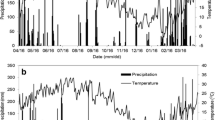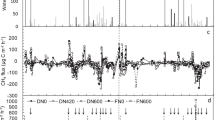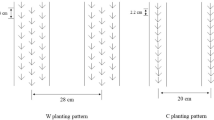Abstract
Background and aims
Inappropriate irrigation and nitrogen fertilization caused high global warming potential (GWP) while reduced carbon sequestration of farmland systems in arid regions. Understanding the effects of irrigation and nitrogen fertilization on net ecosystem carbon budget (NECB) and its components are crucial to mitigate GWP and increase carbon sequestration.
Methods
A field experiment was carried out to investigate the impact of irrigation and nitrogen fertilization on soil greenhouse gas (GHG) emissions, crop net primary productivity (NPP), NECB and net GWP from spring wheat farmland in arid Northwest China. Three irrigation depth levels, 180, 315, and 450 mm and three nitrogen fertilization levels, 170, 250, and 340 kg ha–1 were designed.
Results
Irrigation and fertilization significantly affected GHG emissions and carbon sequestration of farmland system. Reducing irrigation depth from 450 to 315 mm reduced soil CO2 and N2O emissions but did not significantly reduce NPP. Increasing nitrogen fertilization from 170 kg ha–1 to 250 kg ha–1 improved NPP, but continuously increasing nitrogen input decreased NPP while increasing soil CO2 and N2O emissions. Therefore, the NECB first increased and then decreased, while the net GWP first decreased and then increased as the irrigation depth and nitrogen fertilization decreased. Overall, the moderate irrigation and fertilization treatment (i.e., 315 mm irrigation and 250 kg ha–1 nitrogen fertilization) obtained the highest NECB and the lowest net GWP.
Conclusion
Improving irrigation and fertilization management can increase carbon sequestration and mitigate the net GWP of farmland systems by increasing crop NPP and reducing soil GHG emissions.




Similar content being viewed by others
Data availability
All data generated or analyzed during this study are included in this published article and its supplementary information files.
Change history
15 May 2023
A Correction to this paper has been published: https://doi.org/10.1007/s11104-023-06038-y
References
Bateman EJ, Baggs EM (2005) Contributions of nitrification and denitrification to N2O emissions from soils at different water-filled pore space. Biol Fertility Soils 41(6):379–388
Behera SN, Sharma M, Aneja VP, Balasubramanian R (2013) Ammonia in the atmosphere: a review on emission sources, atmospheric chemistry and deposition on terrestrial bodies. Environ Sci Pollut Res 20(11):8092–8131
Bhandari M, Ma Y, Men M, Wu M, Xue C, Wang Y, Li Y, Peng Z (2020) Response of winter wheat yield and soil N2O emission to nitrogen fertilizer reduction and nitrapyrin application in North China Plain. Commun Soil Sci Plant Anal 51(4):554–565
Butterbach-Bahl K, Baggs EM, Dannenmann M, Kiese R, Zechmeister-Boltenstern S (2013) Nitrous oxide emissions from soils: how well do we understand the processes and their controls? Phil Trans Biol Sci 368:1–13
Chen Z, Huang G, Li Y, Zhang X, Xiong Y, Huang Q, Jin S (2022) Effects of the lignite bioorganic fertilizer on greenhouse gas emissions and pathways of nitrogen and carbon cycling in saline-sodic farmlands at Northwest China. J Clean Prod 334:130080
Damme MV, Clarisse L, Whitburn S, Hadji-Lazaro J, Hurtmans D, Clerbaux C, Coheur PF (2018) Industrial and agricultural ammonia point sources exposed. Nature 564:99–103
Fierer N, Schimel JP (2003) A proposed mechanism for the pulse in carbon dioxide production commonly observed following the rapid rewetting of a dry soil. Soil Sci Soc Am J 67:798–805
Foltz ME, Zilles JL, Koloutsou-Vakakis S (2019) Prediction of N2O emissions under different field management practices and climate conditions. Sci Total Environ 646:872–879
Halverson LJ, Jones TM, Firestone MK (2000) Release of intracellular solutes by four soil bacteria exposed to dilution stress. Soil Sci Soc Am J 63:1630–1637
Huang RJ, Zhang Y, Bozzetti C, Ho KF, Cao JJ et al (2014) High secondary aerosol contribution to particulate pollution during haze events in China. Nature 514:218–222
IPCC (2014) Climate Change 2014-mitigation of Climate Change: Working Group I Contribution to the Fourth Assessment Report of the IPCC. Cambridge University Press, Cambridge
IPCC (2021) Summary for Policymakers. In: Climate Change 2021: the Physical Science Basis. Contribution of Working Group I to the Sixth Assessment Report of the Intergovernmental Panel on Climate Change. Cambridge University Press
Kallenbach CM, Rolston DE, Horwath WR (2010) Cover cropping affects soil N2O and CO2 emissions differently depending on type of irrigation. Agric Ecosyst Environ 137(3–4):251–260
Kamyab H, Lim JS, Khademi T, Ho WS, Ahmad R, Hashim H, Siong HC, Keyvanfar A, Lee CT (2015) Greenhouse gas emission of organic waste composting: A case study of universiti teknologi malaysia green campus flagship project. J Teknol 74:113–117
Kamran M, Yan Z, Ahmad I, Jia Q, Ghani MU, Chen X, Chang S, Li T, Siddique KHM, Fahad S, Hou F (2023) Assessment of greenhouse gases emissions, global warming potential and net ecosystem economic benefits from wheat field with reduced irrigation and nitrogen management in an arid region of China. Agric Ecosyst Environ 341:108197
Kirkby J, Curtius J, Almeida J, Dunne E, Duplissy J et al (2011) Role of sulphuric acid, ammonia and galactic cosmic rays in atmospheric aerosol nucleation. Nature 476:429–433
Lam SK, Chen D, Norton R, Armstrong R, Mosier AR (2012) Influence of elevated atmospheric carbon dioxide and supplementary irrigation on greenhouse gas emissions from a spring wheat crop in southern Australia. J Agric Sci 151(2):201–208
Le Mer J, Roger P (2001) Production, oxidation, emission and consumption of methane by soils: a review. Eur J Soil Biol 37:25–50
Li B, Fan C, Zhang H, Chen Z, Sun L, Xiong Z (2015) Combined effects of nitrogen fertilization and biochar on the net global warming potential, greenhouse gas intensity and net ecosystem economic budget in intensive vegetable agriculture in southeastern China. Atmos Environ 100:10–19
Li Y, Xu J, Liu S, Qi Z, Wang H, Wei Q, Gu Z, Liu X, Hameed F (2019) Salinity-induced concomitant increases in soil ammonia volatilization and nitrous oxide emission. Geoderma 361:114053
Li C, Xiong Y, Huang Q, Xu X, Huang G (2020) Impact of irrigation and fertilization regimes on greenhouse gas emissions from soil of mulching cultivated maize (Zea mays L.) field in the upper reaches of Yellow River, China. J Clean Prod 259:120873
Li H, Han X (2014) Estimation of carbon balance under different land uses and long-term fertilizations in black soils of Northeast China. Chinese J Eco-Agric 22(1):16–21 (In Chinese)
Li Y, Huang G, Chen Z, Xiong Y, Huang Q, Xu X, Huo Z (2022) Effects of irrigation and fertilization on grain yield, water and nitrogen dynamics and their use efficiency of spring wheat farmland in an arid agricultural watershed of Northwest China. Agric. Water Manage 260:107277
Li X, Zhu Z, Dong H, Yang L, Zhang X, Guo H (2016) Effects of reduced n fertilizer application on greenhouse gas emissions from wheat fields in Huang-huai-hai Area. Soils and Crops 5(4):215–222 (In Chinese)
Liang Y, Han X, Qiao Y, Li L, You M (2012) Soil respiration and carbon budget in black soils of wheat maize-soybean rotation system. Chinese J Eco-Agric 20(4):395–401 (In Chinese)
Liu C, Wang K, Meng S, Zheng X, Zhou Z, Han S, Chen D, Yang Z (2011) Effects of irrigation, fertilization and crop straw management on nitrous oxide and nitric oxide emissions from a wheat–maize rotation field in northern China. Agric Ecosyst Environ 140:226–233
Liu C, Wang K, Zheng X (2012) Responses of N2O and CH4 fluxes to fertilizer nitrogen addition rates in an irrigated wheat-maize cropping system in Northern China. Biogeosciences 9(2):851–851
Liu C, Yao Z, Wang K, Zheng X, Li B (2019) Net ecosystem carbon and greenhouse gas budgets in fiber and cereal cropping systems. Sci Total Environ 647:895–904
Liu H, Liu S (2008) Effect of different nitrogen levels on soil CO2 fluxes of winter wheat in north China plain. Ecol Environ 17(3):1125–1129 (In Chinese)
Liu X, Ju X, Zhang F, Pan J, Christie P (2003) Nitrogen dynamics and budgets in a winter wheat–maize cropping system in the North China Plain. Field Crops Res 83:111–124
Lyu X, Wang T, Ma Z, Zhao C, Siddique KHM, Ju X (2019) Enhanced efficiency nitrogen fertilizers maintain yields and mitigate global warming potential in an intensified spring wheat system. Field Crops Res. 244
Mon J, Bronson KF, Hunsaker DJ, Thorp KR, White JW, French AN (2016) Interactive effects of nitrogen fertilization and irrigation on grain yield, canopy temperature, and nitrogen use efficiency in overhead sprinkler-irrigated durum wheat. Field Crops Res 191:54–65
Oertel C, Matschullat J, Zurba K, Zimmermann F, Erasmi S (2016) Greenhouse gas emissions from soils-A review. Geochemistry 76(3):327–352
Ozdogan M (2011) Exploring the potential contribution of irrigation to global agricultural primary productivity. Global Biogeochem Cy 25(3):003720
Pan B, Lam SK, Mosier A, Luo Y, Chen D (2016) Ammonia volatilization from synthetic fertilizers and its mitigation strategies: A global synthesis. Agric Ecosyst Environ 232:283–289
Pareja-Sachez E, Cantero-Martínez C, Alvaro-Fuentes J, Plaza-Bonilla D (2019) Tillage and nitrogen fertilization in irrigated maize: key practices to reduce soil CO2 and CH4 emissions. Soil Tillage Res 191:29–36
Plaza-Bonilla D, Cantero-Martínez C, Bareche J, Arrúe JL, Alvaro-Fuentes J (2014) Soil carbon dioxide and methanefluxes as affected by tillage and N fertilization in dryland conditions. Plant Soil 381:111–130
Pryor SW, Smithers J, Lyne P, van Antwerpen R (2017) Impact of agricultural practices on energy use and greenhouse gas emissions for South African sugarcane production. J Clean Prod 141:137–145
Ren D, Xu X, Hao Y, Huang G (2016) Modeling and assessing field irrigation water use in a canal system of Hetao, upper Yellow River basin: Application to maize, sunflower and watermelon. J Hydrol 532:122–139
Riley WJ, Ortiz-Monasterio I, Matso PA (2001) Nitrogen leaching and soil nitrate, nitrite, and ammonium levels under irrigated wheat in Northern Mexico. Nutr Cycl Agroecosyst 61:223–236
Sainju UM, Stevens WB, Caesar-Tonthat T, Liebig MA (2012) Soil greenhouse gas emissions affected by irrigation, tillage, crop rotation, and nitrogen fertilization. J Environ Qual 41(6):1774–1786
Scheer C, Grace PR, Rowlings DW, Payero J (2012) Nitrous oxide emissions from irrigated wheat in Australia: impact of irrigation management. Plant Soil 359:351–362
Scheer C, Wassmann R, Kienzler K, Ibragimov N, Eschanov R (2008) Nitrous oxide emissions from fertilized, irrigated cotton (Gossypium hirsutum L.) in the Aral Sea Basin, Uzbekistan: Influence of nitrogen applications and irrigation practices. Soil Biol. Biochem. 40 (2), 290–301
Shirazi MA, Boersma L (1984) A Unifying Quantitative Analysis of Soil Texture. Soil Sci Soc Am J 48:142–147
Snyder CS, Bruulsema TW, Jensen TL, Fixen PE (2009) Review of greenhouse gas emissions from crop production systems and fertilizer management effects. Agric Ecosyst Environ 133(3–4):247–266
Tan N, Lin Q, Jiang W, Liu Y, Li L (2011) Effect of limited irrigation on diurnal variation in flag-leaf photosynthesis and yield of dryland wheat. Chinese J Eco-Agric 19(4):805–811 (In Chinese)
Verstraete W, Focht DD (1977) Biochemical ecology of nitrification and denitrification. Adv Microb Ecol
Wang X, Cai H, Li L, Xu T, Chen H (2019) Effects of water deficit on greenhouse gas emission in wheat field in different periods. Environ Sci 40(5):2413–2424 (in Chinese)
Weintraub MN, Schimel JP (2003) Interactions between Carbon and Nitrogen Mineralization and Soil Organic Matter Chemistry in Arctic Tundra Soils. Ecosystems 6(2):129–143
Xiong H, Zhang B, Li J, Zhang X, Shi J (2020) Effects of irrigation amount on emission of N2O and CO2 from winter wheat field. J Irrig Drain 39(9):41–50 (In Chinese)
Zhang H, Tang J, Liang S, Li Z, Yang P, Wang J, Wang S (2017a) The Emissions of Carbon Dioxide, Methane, and Nitrous Oxide during Winter without Cultivation in Local Saline-Alkali Rice and Maize Fields in Northeast China. Sustainability 9(10):1916–1932
Zhang JB, Song CC, Yang WY (2005) Cold season CH4, CO2 and N2O fluxes from freshwater marshes in northeast China. Chemosphere 59(11):1703–1705
Zhang K, Zheng H, Chen F, Li R, Yang M, Ouyang Z, Lan J, Xiang X (2017b) Impact of nitrogen fertilization on soil-Atmosphere greenhouse gas exchanges in eucalypt plantations with different soil characteristics in southern China. PLoS One. 12 (2)
Zhang X, Meng F, Li H, Wang L, Wu S, Xiao G, Wu W (2019) Optimized fertigation maintains high yield and mitigates N2O and NO emissions in an intensified wheat–maize cropping system. Agric Water Manage 211:26–36
Acknowledgements
This research was jointly supported by the National Natural Science Foundation of China (U2243217, 52220105007) and the Key Research Project of Science and Technology in Inner Mongolia Autonomous Region of China (2020, 2021).
Author information
Authors and Affiliations
Contributions
Yue Li: Investigation, Formal analysis, Writing—original draft. Rong Wang: Data curation. Zhijun Chen: Investigation. Yunwu Xiong: Methodology. Quanzhong Huang: Conceptualization. Guanhua Huang: Supervision, Writing—review & editing.
Corresponding author
Ethics declarations
Competing interests
The authors have no relevant financial or non-financial interests to disclose.
Additional information
Responsible Editor: Iain Paul Hartley.
Publisher's Note
Springer Nature remains neutral with regard to jurisdictional claims in published maps and institutional affiliations.
Supplementary Information
Below is the link to the electronic supplementary material.
Rights and permissions
Springer Nature or its licensor (e.g. a society or other partner) holds exclusive rights to this article under a publishing agreement with the author(s) or other rightsholder(s); author self-archiving of the accepted manuscript version of this article is solely governed by the terms of such publishing agreement and applicable law.
About this article
Cite this article
Li, Y., Wang, R., Chen, Z. et al. Increasing net ecosystem carbon budget and mitigating global warming potential with improved irrigation and nitrogen fertilization management of a spring wheat farmland system in arid Northwest China. Plant Soil 489, 193–209 (2023). https://doi.org/10.1007/s11104-023-06006-6
Received:
Accepted:
Published:
Issue Date:
DOI: https://doi.org/10.1007/s11104-023-06006-6




